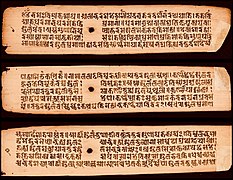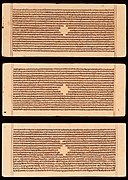Bṛhat Saṃhitā
Bṛhat-saṃhitā[a] is a 6th-century Sanskrit-language encyclopedia compiled by Varāhamihira in present-day Ujjain, India. Besides the author's area of expertise—astrology and astronomy—the work contains a wide variety of other topics.His book is divided into 3 sections namely Tantra, Hora and Samhita.
Contents
[edit]According to the penultimate verse of the text, it contains 100 chapters in less than 4000 shlokas (verses). Sudhakara Dvivedi's edition of the text, with Utpala's commentary, contains 105 chapters, plus the last chapter containing the table of contents; H. Kern's edition contains an additional chapter (#36) titled Raja-lakshnam. According to Utpala, Varahamihira excludes five chapters from the contents, thus arriving at 100 as the number of chapters; However, Varahamihira himself excludes 3 more chapters from the table of contents, bringing the number of chapters to only 97; so, it is not clear how exactly is the number 100 is arrived at.[3]
Utpala cites the authorship of one of the excluded chapters to Vidhya-vasin. He also declares four verses to be spurious, and does not comment on two additional verses, which suggests that these may be later interpolations.[4]
- Introduction
- Canons for Astrologers
- Transit of the Sun
- Transit of the Moon
- Course of Rahu
- Transit of Mars
- Transit of Mercury
- Course of Jupiter
- Course of Venus
- Transit of Saturn
- Comets
- Canopus
- Course of the Seven Sages (Big Dipper)
- Divisions of globe
- Stellar rulership
- Planetary rulership
- Planetary wars
- Conjunction of the Moon with planets of stars
- Planetary years and effects
- The Planetary Triangle
- Pregnancy of Clouds
- Retention of Embryo
- Rainfall
- The Moon's Conjunction with Rohini
- The Moon's Conjunction with Svati
- The Moon's Conjunction with Asadha
- The Wind Circle
- Signs of Immediate Rain
- Prognostics from Flowers and Creepers
- Indications at Dawn and Twilight
- Glow at the Horizon
- Signs of Earthquake
- Signs of Meteors
- Characteristics of Halos
- Signs of Rainbows
- Signs of Aerial City
- Mock Suns
- Indications of Haze
- Symptoms of Hurricane
- Growth of Crops
- Classification of Substances
- Fluctuations of Prices
- Glory of Indra's Banner
- Lustration Ceremony
- The Wagtail
- Portentous Phenomena
- Motley Miscellany
- Royal Ablution
- Signs of Crowns
- Signs of Swords
- Science of Limbs
- Characteristics of Pimples
- Architecture
- Exploration of Water Springs
- Treatment of Trees
- Description of Temples
- Preparation of Adamantine Glue.
- Description of Idols
- Entering Forest
- Installation of Images
- Features of Cows
- Characteristics of Dogs
- Signs of Cocks
- Characteristics of Toroises
- Signs of Goats
- Characteristics of Horses
- Signs of Elephants
- Signs of Men
- Signs of the Great Five Men
- Characteristics of Maidens
- Omens from Slits of Garments
- Signs of Chowries
- Signs of Umbrellas
- Praise of Women
- Winning of Affection
- Erotic Recipes
- Preparation of Perfumes
- Union of Man and Woman
- Signs of Couches and Seats
- Examination of Gems
- Signs of Pearls
- Signs of Rubies
- Signs of Emeralds
- Signs of Lamps
- Token of Tooth Sticks
- Omens through Birds and Beasts
- The Circle of Quarters
- Cries of Birds and Beasts
- The Circle of Dogs
- The Cries of Jackals
- Behaviour of Wild Animals
- Intention of Cows
- Intention of Horses
- Attitude of Elephants
- Cries of Crows
- Further Omens
- Time of Frution of Effects
- Functions and Properties of Asterisms
- Functions and Properties of Lunar Days
- Qualities of the Karanas
- Effects of Birth in the Asterisms
- Division of the Zodiac
- Planerary Combinations at Marriage
- Transits of Planets
- Worship of the Stellar Day
- Conclusion
The contents of the text fall into two major categories: anga and upanga. The anga discusses divination based on planets, asterisms, and zodiac signs. The upanga discusses a wide variety of other topics, as listed above. Varāhamihira does not discuss several traditional topics which he considers legendary and unscientific.[6]
The text displays Varāhamihira's skill as a poet:[7] it uses at least 63 different metres (Arya being the most frequent) in the Brihat-samhita.[8]
- Manuscripts of Bṛhat Saṃhitā
-
1279 CE palm-leaf manuscript from a Buddhist monastery
-
Devanagari manuscript from a Jain temple
-
Manuscript with Utpala's commentary in Grantha script
Influence
[edit]Varāhamihira's text became far more popular than earlier similar texts, because of its comprehensiveness, lucidity, appealing presentation, and literary merit. He wrote an abridged version of the text, Samāsa Saṃhitā, which is now lost and is known only from Utpala's commentary on Brhat-samhita.[9]
According to Varāhamihira, in some verses he was merely summarizing earlier existing literature on astronomy, Shilpa Sastra and temple architecture, yet his presentation of different theories and models of design are among the earliest texts that have survived.[10][11]
Several chapters of the text - such as Chitraymayura, Drgargala (Jalagala-shastra) and Prasada-lakshana - were studied as independent treatises by later scholars, who regarded Varāhamihira as an authority on a variety of topics.[12] 11th-century Iranian scholar Al-Biruni also quotes Brhat-samhita.[13]
Abd Al-Aziz ibn Shams ibn Baha' Nuri Dihlavwi (fl. c. 1350/1375) composed Tarjamah i Barahi, a Persian translation of Brhat-samhita, for the Delhi Sultan Firuz Shah Tughluq.[14]
For modern scholars, the wide range of the text makes it a very useful source of history about the contemporary period.[6]
Editions
[edit]Printed editions and translations of the text include:[15]
- 1895-97, Varanasi: Edited with Bhattotpala's commentary by Sudhakara Dvivedi (2 volumes)
- 1865, Calcutta: Edited by H. Kern
- 1870-1875: English translation by H. Kern in Journal of the Royal Asiatic Society
- 1947, Bangalore: Text with English translation by V. Subrahmanya Sastri and M. Ramakrishna Bhat (2 volumes)
Notes
[edit]References
[edit]- ^ Ariel Glucklich (2008). The Strides of Vishnu: Hindu Culture in Historical Perspective. Oxford University Press. p. 10. ISBN 978-0-19-971825-2.
- ^ A.M. Shastri 1991, pp. 19–20.
- ^ A.M. Shastri 1969, pp. 37–38.
- ^ A.M. Shastri 1969, p. 38.
- ^ M.R. Bhatt 1996, Contents.
- ^ a b A.M. Shastri 1991, p. 21.
- ^ A.M. Shastri 1969, p. 37.
- ^ A.M. Shastri 1969, p. 15.
- ^ A.M. Shastri 1991, p. 22.
- ^ Michael Meister (2003). Gudrun Bühnemann (ed.). Maṇḍalas and Yantras in the Hindu Traditions. BRILL Academic. pp. 251–260. ISBN 90-04-12902-2.
- ^ T. A. Gopinatha Rao (1985). Elements of Hindu Iconography. Motilal Banarsidass. pp. 25, 58–59. ISBN 978-81-208-0878-2.
- ^ A.M. Shastri 1991, pp. 21–22.
- ^ Varahamihira; M Ramakrishna Bhat (1996). Brhat Samhita of Varahamihira, Part 2. Motilal Banarsidass. pp. 960–961. ISBN 978-81-208-1060-0.
- ^ David Pingree, ed. (1970). Census of the Exact Sciences in Sanskrit Series A. Vol. 1. American Philosophical Society. p. 13.
- ^ A.M. Shastri 1991, p. 216.
Bibliography
[edit]- A.M. Shastri (1991). Varāhamihira and His Times. Kusumanjali. OCLC 28644897.
- A.M. Shastri (1969). India as Seen in the Bṛhatsaṁhitā of Varāhamihira. Motilal Banarsidass. ISBN 9780896842212.
- M. Ramakrishna Bhat, ed. (1996) [1982]. Brhat Samhita of Varahamihira (Second ed.). Motilal Banarsidass. ISBN 9788120810600.
External links
[edit]- Sanskrit text and English translation (1946) by V. Subrahmanya Sastri and M. Ramakrishna Bhat
- Sanskrit text (1865) edited by H. Kern



